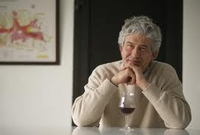With apologies to Justice Potter Stewart, I can’t define terroir, but I know it when I taste it.
Certainly Burgundy is ground zero for the concept of terroir. With two grapes, Burgundians make hundreds of different and unique wines. Jacques Lardière, Maison Louis Jadot’s  legendary winemaker of 40 years, told me once, “If you taste Chardonnay in my wines, I’ve made a mistake.” He, of course, was referring to terroir. Despite the same grapes (Chardonnay) the wines from the neighboring villages Chassagne-Montrachet and Puligny-Montrachet are very different because of where that grape grows. And even with those villages, the wines from the adjacent premier cru vineyards of Les Referts and Les Perrières (both in Puligny-Montrachet) are distinctly different. Just this week, I had a bottle of each — 2002s from Jadot — from my cellar. Both were excellent: The Referts was richer and more honeyed whereas the Perrières was more precise and mineraly. (No mistakes here, Jacques).
legendary winemaker of 40 years, told me once, “If you taste Chardonnay in my wines, I’ve made a mistake.” He, of course, was referring to terroir. Despite the same grapes (Chardonnay) the wines from the neighboring villages Chassagne-Montrachet and Puligny-Montrachet are very different because of where that grape grows. And even with those villages, the wines from the adjacent premier cru vineyards of Les Referts and Les Perrières (both in Puligny-Montrachet) are distinctly different. Just this week, I had a bottle of each — 2002s from Jadot — from my cellar. Both were excellent: The Referts was richer and more honeyed whereas the Perrières was more precise and mineraly. (No mistakes here, Jacques).
But the French don’t have a monopoly on terroir. Cabernet Sauvignon from Stag’s Leap District in California has a different – smoother — texture than Cabernet from other parts of Napa Valley. Indeed, Conn Creek has an AVA Room where consumers can sample Cabernet from the different sub-AVAs within Napa all made by the same winemaking team using the same techniques that vividly demonstrates the wonderful diversity of Cabernet within the Napa Valley. Conn Creek offers a two-hour seminar twice daily (by appointment only) that allows customers to taste the different Cabernets and then make their own blend.
The major impediment to understanding the concept of terroir is finding pure examples of it. If you compare Mondavi’s Napa Valley Cabernet with Jordan’s from the Alexander Valley, are you tasting the differences between Napa and Alexander Valleys or the blend (Jordan’s 2007 is 75% Cabernet while Mondavi’s is 86%) or the producers’ styles? To find examples of terroir in Burgundy is easy because a producer makes scores of wines from the same grape from different vineyards. So a consumer can eliminate the variable of the blend and the producer’s hand. Conn Creek’s AVA Room also overcomes the major problem in identifying terroir: separating it from the hand of the winemaker. Similarly, Nickel & Nickel produces a stellar lineup of Cabernets from single vineyard sites within the Napa Valley that also emphasizes the  importance and distinctiveness of place.
importance and distinctiveness of place.
A splendid — and very well priced — trio of red wines from DonnaChiara, a new producer from Campania (imported by Michelangelo Imports) demonstrates dramatically the importance of the terroir driven hierarchical ranking in that region of southern Italy. The wines are all made from Aglianico, Campania’s and southern Italy’s most illustrious red grape, grown in roughly the same area. Illaria Petito, managing director and 5th generation of women running the family estate, and Angelo Valentino, the winemaker who has worked with Zind-Humbrecht and Domaine Michelot, terroir-focused wineries in Alsace and Burgundy, respectively, led the team that made all the wines.
The first, the 2008 Aglianico (IGT Campania, $18) receives no oak aging, which allows an alluring dark fruitiness coupled with remarkably smooth tannins to shine. Ready to drink now, it is easy to recommend with substantial pasta dishes. The 2008 Aglianico from the Irpinia DOC zone ($20) delivers more minerality and depth, which comes from a selection of better grapes. The tannins are also beautifully polished, not an easy accomplishment when dealing with the Aglianico grape, and allows for current consumption with robust fare this fall and winter. The 2007 Taurasi DOCG ($35) sits majestically at the top of the prestige pyramid. With its incredible layers of floral nuances and tarry minerality it justifies the DOCG ranking of Taurasi. It’s best suited for the cellar as opposed to the dinner table at this stage. Its balance and harmony suggest it will develop marvelously with 5 or 10 years of cellaring.
2
